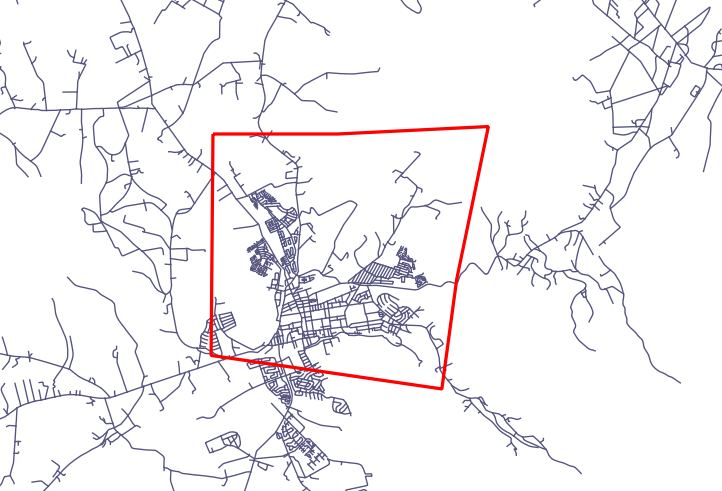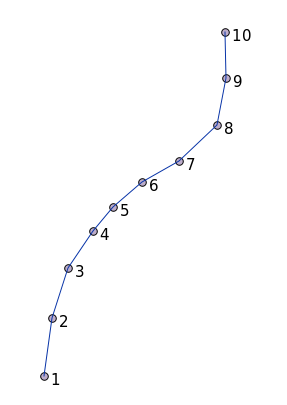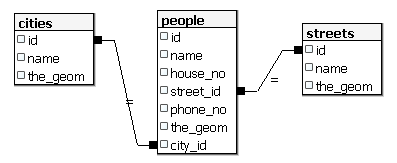16.5. Lesson: ジオメトリの構成¶
このセクションではシンプルなジオメトリが SQL でどのように構成されているか少し掘り下げます。実際には、複雑なジオメトリをデジタイジングツールを使用して作るためには、QGIS のような GIS を使用するでしょう。しかし、それらがどのように形作られているかを知ることは、クエリを書いたりデータベースがどのように作られているかを理解するのに役立ちます。
このレッスンの目的 PostgreSQL/PostGIS で空間要素を直接作成する方法をよく理解する。
16.5.1. ラインストリングの作成¶
Going back to our address database, let’s get our streets table matching the others; i.e., having a constraint on the geometry, an index and an entry in the geometry_columns table.
16.5.2. Try Yourself  ¶
¶
- Modify the streets table so that it has a geometry column of type ST_LineString.
- Don’t forget to do the accompanying update to the geometry columns table!
- Also add a constraint to prevent any geometries being added that are not LINESTRINGS or null.
新しいジオメトリカラムに空間インデックスを作成します。
では、ラインストリングをstreetsテーブルに挿入しましょう。この場合は、既存の道路のレコードを更新します
update streets set the_geom = 'SRID=4326;LINESTRING(20 -33, 21 -34, 24 -33)'
where streets.id=2;
結果をQGISで確認してみます。(‘レイヤ’ パネルのstreetsレイヤを右クリックし、’レイヤの領域にズームする’を選択する必要があるかもしれません。)
いくつかはQGISから、いくつかはコマンドラインから道路の要素をもう少し追加します。
16.5.3. ポリゴンの作成¶
ポリゴンを作成することも簡単です。覚えておくことは、定義により、ポリゴンは最低4つの頂点を持ち、最初と最後の頂点は同じ場所になるということです:
insert into cities (name, the_geom)
values ('Tokyo', 'SRID=4326;POLYGON((10 -10, 5 -32, 30 -27, 10 -10))');
ノート
A polygon requires double brackets around its coordinate list; this is to allow you to add complex polygons with multiple unconnected areas. For instance
insert into cities (name, the_geom)
values ('Tokyo Outer Wards', 'SRID=4326;POLYGON((20 10, 20 20, 35 20, 20 10),
(-10 -30, -5 0, -15 -15, -10 -30))');
If you followed this step, you can check what it did by loading the cities dataset into QGIS, opening its attribute table, and selecting the new entry. Note how the two new polygons behave like one polygon.
16.5.4. 練習:CitiesをPeopleにリンクする¶
For this exercise you should do the following:
peopleテーブルからすべてのデータを削除します。
- Add a foreign key column to people that references the primary key of the cities table.
いくつかの年をキャプチャするためQGISを使います。
- Use SQL to insert some new people records, ensuring that each has an associated street and city.
Your updated people schema should look something like this:
\d people
Table "public.people"
Column | Type | Modifiers
-----------+-----------------------+--------------------------------------------
id | integer | not null
| | default nextval('people_id_seq'::regclass)
name | character varying(50) |
house_no | integer | not null
street_id | integer | not null
phone_no | character varying |
the_geom | geometry |
city_id | integer | not null
Indexes:
"people_pkey" PRIMARY KEY, btree (id)
"people_name_idx" btree (name)
Check constraints:
"people_geom_point_chk" CHECK (st_geometrytype(the_geom) =
'ST_Point'::text OR the_geom IS NULL)
Foreign-key constraints:
"people_city_id_fkey" FOREIGN KEY (city_id) REFERENCES cities(id)
"people_street_id_fkey" FOREIGN KEY (street_id) REFERENCES streets(id)
16.5.6. Try Yourself  ¶
¶
Create city boundaries by computing the minimum convex hull of all addresses for that city and computing a buffer around that area.
16.5.7. サブオブジェクトへのアクセス¶
With the SFS-Model functions, you have a wide variety of options to access sub-objects of SFS Geometries. When you want to select the first vertex point of every polygon geometry in the table myPolygonTable, you have to do this in this way:
Transform the polygon boundary to a linestring:
select st_boundary(geometry) from myPolygonTable;
Select the first vertex point of the resultant linestring:
select st_startpoint(myGeometry) from ( select st_boundary(geometry) as myGeometry from myPolygonTable) as foo;
16.5.8. データプロセッシング¶
PostGIS supports all OGC SFS/MM standard conform functions. All these functions start with ST_.
16.5.9. クリッピング¶
To clip a subpart of your data you can use the ST_INTERSECT() function. To avoid empty geometries, use:
where not st_isempty(st_intersection(a.the_geom, b.the_geom))

select st_intersection(a.the_geom, b.the_geom), b.*
from clip as a, road_lines as b
where not st_isempty(st_intersection(st_setsrid(a.the_geom,32734),
b.the_geom));

16.5.10. Building Geometries from Other Geometries¶
From a given point table, you want to generate a linestring. The order of the points is defined by their id. Another ordering method could be a timestamp, such as the one you get when you capture waypoints with a GPS receiver.

To create a linestring from a new point layer called ‘points’, you can run the following command:
select ST_LineFromMultiPoint(st_collect(the_geom)), 1 as id
from (
select the_geom
from points
order by id
) as foo;
To see how it works without creating a new layer, you could also run this command on the ‘people’ layer, although of course it would make little real-world sense to do this.

16.5.11. ジオメトリクリーニング¶
You can get more information for this topic in this blog entry.
16.5.12. テーブル間の違い¶
To detect the difference between two tables with the same structure, you can use the PostgreSQL keyword EXCEPT:
select * from table_a
except
select * from table_b;
As the result, you will get all records from table_a which are not stored in table_b.
16.5.13. 表領域¶
You can define where postgres should store its data on disk by creating tablespaces:
CREATE TABLESPACE homespace LOCATION '/home/pg';
When you create a database, you can then specify which tablespace to use e.g.:
createdb --tablespace=homespace t4a
16.5.14. In Conclusion¶
You’ve learned how to create more complex geometries using PostGIS statements. Keep in mind that this is mostly to improve your tacit knowledge when working with geo-enabled databases through a GIS frontend. You usually won’t need to actually enter these statements manually, but having a general idea of their structure will help you when using a GIS, especially if you encounter errors that would otherwise seem cryptic.
